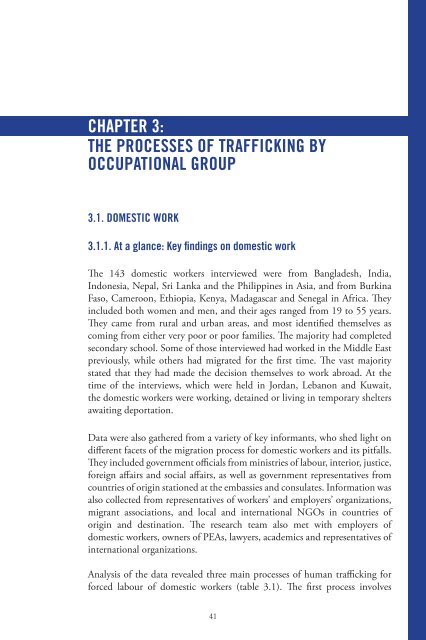Tricked and Trapped: Human Trafficking in the Middle East, ‎pdf 4.1 MB
Tricked and Trapped: Human Trafficking in the Middle East, ‎pdf 4.1 MB
Tricked and Trapped: Human Trafficking in the Middle East, ‎pdf 4.1 MB
You also want an ePaper? Increase the reach of your titles
YUMPU automatically turns print PDFs into web optimized ePapers that Google loves.
CHAPTER 3:<br />
THE PROCESSES OF TRAFFICKING BY<br />
OCCUPATIONAL GROUP<br />
3.1. DOMESTIC WORK<br />
3.1.1. At a glance: Key f<strong>in</strong>d<strong>in</strong>gs on domestic work<br />
The 143 domestic workers <strong>in</strong>terviewed were from Bangladesh, India,<br />
Indonesia, Nepal, Sri Lanka <strong>and</strong> <strong>the</strong> Philipp<strong>in</strong>es <strong>in</strong> Asia, <strong>and</strong> from Burk<strong>in</strong>a<br />
Faso, Cameroon, Ethiopia, Kenya, Madagascar <strong>and</strong> Senegal <strong>in</strong> Africa. They<br />
<strong>in</strong>cluded both women <strong>and</strong> men, <strong>and</strong> <strong>the</strong>ir ages ranged from 19 to 55 years.<br />
They came from rural <strong>and</strong> urban areas, <strong>and</strong> most identified <strong>the</strong>mselves as<br />
com<strong>in</strong>g from ei<strong>the</strong>r very poor or poor families. The majority had completed<br />
secondary school. Some of those <strong>in</strong>terviewed had worked <strong>in</strong> <strong>the</strong> <strong>Middle</strong> <strong>East</strong><br />
previously, while o<strong>the</strong>rs had migrated for <strong>the</strong> first time. The vast majority<br />
stated that <strong>the</strong>y had made <strong>the</strong> decision <strong>the</strong>mselves to work abroad. At <strong>the</strong><br />
time of <strong>the</strong> <strong>in</strong>terviews, which were held <strong>in</strong> Jordan, Lebanon <strong>and</strong> Kuwait,<br />
<strong>the</strong> domestic workers were work<strong>in</strong>g, deta<strong>in</strong>ed or liv<strong>in</strong>g <strong>in</strong> temporary shelters<br />
await<strong>in</strong>g deportation.<br />
Data were also ga<strong>the</strong>red from a variety of key <strong>in</strong>formants, who shed light on<br />
different facets of <strong>the</strong> migration process for domestic workers <strong>and</strong> its pitfalls.<br />
They <strong>in</strong>cluded government officials from m<strong>in</strong>istries of labour, <strong>in</strong>terior, justice,<br />
foreign affairs <strong>and</strong> social affairs, as well as government representatives from<br />
countries of orig<strong>in</strong> stationed at <strong>the</strong> embassies <strong>and</strong> consulates. Information was<br />
also collected from representatives of workers’ <strong>and</strong> employers’ organizations,<br />
migrant associations, <strong>and</strong> local <strong>and</strong> <strong>in</strong>ternational NGOs <strong>in</strong> countries of<br />
orig<strong>in</strong> <strong>and</strong> dest<strong>in</strong>ation. The research team also met with employers of<br />
domestic workers, owners of PEAs, lawyers, academics <strong>and</strong> representatives of<br />
<strong>in</strong>ternational organizations.<br />
Analysis of <strong>the</strong> data revealed three ma<strong>in</strong> processes of human traffick<strong>in</strong>g for<br />
forced labour of domestic workers (table 3.1). The first process <strong>in</strong>volves<br />
41
















